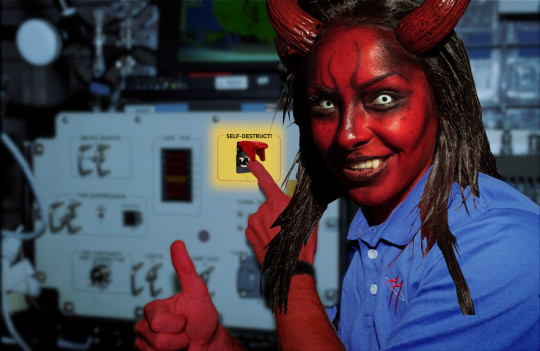#with the self destruct button
Explore tagged Tumblr posts
Text

Naturally, the Globnors would design a weapons console
with the self-destruct button right next to the ‘launch’ one. Good thing they were labelled, right?
#Inspector Spacetime#Caps Lock Num Lock Missiles Lock (trope)#Caps Lock Num Lock Missiles Lock#Globnors (species)#naturally#they design a weapons console#weapons console#with the self destruct button#Self Destruct Mechanism (trope)#Self Destruct Mechanism#right next to#launch button#good thing#they were labelled
0 notes
Text









CANDACE AGAINST THE UNIVERSE (2020)
#mine#gifs#phineas and ferb#phineasandferbedit#disneyedit#phineas and ferb the movie#candace against the universe#heinz doofenshmirtz#perry the platypus#vanessa doofenshmirtz#userstream#filmtvgifs#animationdaily#animationsource#cartoonedit#dailyanimatedgifs#filmgifs#userthing#usersource#i'm sorry i laughed way too hard at this#the axe-inator SENT ME adsfdgfhjgh#the self-destruct button 😭
527 notes
·
View notes
Text
i can’t wait for the hells, if they all survive this campaign, to just never stop bringing this up ever but in completely unrelated circumstances. just. oh ashton wants to go to lunch at a different spot? remember that time you ate the essence of a second primordial shard and forced us to watch you all die? you don’t get an opinion we’re going to taco bell
#cr#cr3#cr spoilers#ashton greymoore#the hells have an instawin argument button now#and it’s going to be the funniest shit i’ve ever seen#ashton is never going to be allowed to comment on anyone’s self destruction ever again
1K notes
·
View notes
Text
THE funniest thing about the phineas and ferb star wars special is how when phineas and ferb are looking over the death star plans they point out how the like little port thing that they eventually use to blow up the death star is like a self-destruct button
(and, of course, the immediate cut to doofenshmirtz)
just like. the way everything lined up for that comparison is CRAZY to me I start cracking up every time
#phineas and ferb#phineas and ferb star wars#star wars#dr doofenshmirtz#self destruct buttons#death star
152 notes
·
View notes
Text
Demon-haunted computers are back, baby

Catch me in Miami! I'll be at Books and Books in Coral Gables on Jan 22 at 8PM.

As a science fiction writer, I am professionally irritated by a lot of sf movies. Not only do those writers get paid a lot more than I do, they insist on including things like "self-destruct" buttons on the bridges of their starships.
Look, I get it. When the evil empire is closing in on your flagship with its secret transdimensional technology, it's important that you keep those secrets out of the emperor's hand. An irrevocable self-destruct switch there on the bridge gets the job done! (It has to be irrevocable, otherwise the baddies'll just swarm the bridge and toggle it off).
But c'mon. If there's a facility built into your spaceship that causes it to explode no matter what the people on the bridge do, that is also a pretty big security risk! What if the bad guy figures out how to hijack the measure that – by design – the people who depend on the spaceship as a matter of life and death can't detect or override?
I mean, sure, you can try to simplify that self-destruct system to make it easier to audit and assure yourself that it doesn't have any bugs in it, but remember Schneier's Law: anyone can design a security system that works so well that they themselves can't think of a flaw in it. That doesn't mean you've made a security system that works – only that you've made a security system that works on people stupider than you.
I know it's weird to be worried about realism in movies that pretend we will ever find a practical means to visit other star systems and shuttle back and forth between them (which we are very, very unlikely to do):
https://pluralistic.net/2024/01/09/astrobezzle/#send-robots-instead
But this kind of foolishness galls me. It galls me even more when it happens in the real world of technology design, which is why I've spent the past quarter-century being very cross about Digital Rights Management in general, and trusted computing in particular.
It all starts in 2002, when a team from Microsoft visited our offices at EFF to tell us about this new thing they'd dreamed up called "trusted computing":
https://pluralistic.net/2020/12/05/trusting-trust/#thompsons-devil
The big idea was to stick a second computer inside your computer, a very secure little co-processor, that you couldn't access directly, let alone reprogram or interfere with. As far as this "trusted platform module" was concerned, you were the enemy. The "trust" in trusted computing was about other people being able to trust your computer, even if they didn't trust you.
So that little TPM would do all kinds of cute tricks. It could observe and produce a cryptographically signed manifest of the entire boot-chain of your computer, which was meant to be an unforgeable certificate attesting to which kind of computer you were running and what software you were running on it. That meant that programs on other computers could decide whether to talk to your computer based on whether they agreed with your choices about which code to run.
This process, called "remote attestation," is generally billed as a way to identify and block computers that have been compromised by malware, or to identify gamers who are running cheats and refuse to play with them. But inevitably it turns into a way to refuse service to computers that have privacy blockers turned on, or are running stream-ripping software, or whose owners are blocking ads:
https://pluralistic.net/2023/08/02/self-incrimination/#wei-bai-bai
After all, a system that treats the device's owner as an adversary is a natural ally for the owner's other, human adversaries. The rubric for treating the owner as an adversary focuses on the way that users can be fooled by bad people with bad programs. If your computer gets taken over by malicious software, that malware might intercept queries from your antivirus program and send it false data that lulls it into thinking your computer is fine, even as your private data is being plundered and your system is being used to launch malware attacks on others.
These separate, non-user-accessible, non-updateable secure systems serve a nubs of certainty, a remote fortress that observes and faithfully reports on the interior workings of your computer. This separate system can't be user-modifiable or field-updateable, because then malicious software could impersonate the user and disable the security chip.
It's true that compromised computers are a real and terrifying problem. Your computer is privy to your most intimate secrets and an attacker who can turn it against you can harm you in untold ways. But the widespread redesign of out computers to treat us as their enemies gives rise to a range of completely predictable and – I would argue – even worse harms. Building computers that treat their owners as untrusted parties is a system that works well, but fails badly.
First of all, there are the ways that trusted computing is designed to hurt you. The most reliable way to enshittify something is to supply it over a computer that runs programs you can't alter, and that rats you out to third parties if you run counter-programs that disenshittify the service you're using. That's how we get inkjet printers that refuse to use perfectly good third-party ink and cars that refuse to accept perfectly good engine repairs if they are performed by third-party mechanics:
https://pluralistic.net/2023/07/24/rent-to-pwn/#kitt-is-a-demon
It's how we get cursed devices and appliances, from the juicer that won't squeeze third-party juice to the insulin pump that won't connect to a third-party continuous glucose monitor:
https://arstechnica.com/gaming/2020/01/unauthorized-bread-a-near-future-tale-of-refugees-and-sinister-iot-appliances/
But trusted computing doesn't just create an opaque veil between your computer and the programs you use to inspect and control it. Trusted computing creates a no-go zone where programs can change their behavior based on whether they think they're being observed.
The most prominent example of this is Dieselgate, where auto manufacturers murdered hundreds of people by gimmicking their cars to emit illegal amount of NOX. Key to Dieselgate was a program that sought to determine whether it was being observed by regulators (it checked for the telltale signs of the standard test-suite) and changed its behavior to color within the lines.
Software that is seeking to harm the owner of the device that's running it must be able to detect when it is being run inside a simulation, a test-suite, a virtual machine, or any other hallucinatory virtual world. Just as Descartes couldn't know whether anything was real until he assured himself that he could trust his senses, malware is always questing to discover whether it is running in the real universe, or in a simulation created by a wicked god:
https://pluralistic.net/2022/07/28/descartes-was-an-optimist/#uh-oh
That's why mobile malware uses clever gambits like periodically checking for readings from your device's accelerometer, on the theory that a virtual mobile phone running on a security researcher's test bench won't have the fidelity to generate plausible jiggles to match the real data that comes from a phone in your pocket:
https://arstechnica.com/information-technology/2019/01/google-play-malware-used-phones-motion-sensors-to-conceal-itself/
Sometimes this backfires in absolutely delightful ways. When the Wannacry ransomware was holding the world hostage, the security researcher Marcus Hutchins noticed that its code made reference to a very weird website: iuqerfsodp9ifjaposdfjhgosurijfaewrwergwea.com. Hutchins stood up a website at that address and every Wannacry-infection in the world went instantly dormant:
https://pluralistic.net/2020/07/10/flintstone-delano-roosevelt/#the-matrix
It turns out that Wannacry's authors were using that ferkakte URL the same way that mobile malware authors were using accelerometer readings – to fulfill Descartes' imperative to distinguish the Matrix from reality. The malware authors knew that security researchers often ran malicious code inside sandboxes that answered every network query with fake data in hopes of eliciting responses that could be analyzed for weaknesses. So the Wannacry worm would periodically poll this nonexistent website and, if it got an answer, it would assume that it was being monitored by a security researcher and it would retreat to an encrypted blob, ceasing to operate lest it give intelligence to the enemy. When Hutchins put a webserver up at iuqerfsodp9ifjaposdfjhgosurijfaewrwergwea.com, every Wannacry instance in the world was instantly convinced that it was running on an enemy's simulator and withdrew into sulky hibernation.
The arms race to distinguish simulation from reality is critical and the stakes only get higher by the day. Malware abounds, even as our devices grow more intimately woven through our lives. We put our bodies into computers – cars, buildings – and computers inside our bodies. We absolutely want our computers to be able to faithfully convey what's going on inside them.
But we keep running as hard as we can in the opposite direction, leaning harder into secure computing models built on subsystems in our computers that treat us as the threat. Take UEFI, the ubiquitous security system that observes your computer's boot process, halting it if it sees something it doesn't approve of. On the one hand, this has made installing GNU/Linux and other alternative OSes vastly harder across a wide variety of devices. This means that when a vendor end-of-lifes a gadget, no one can make an alternative OS for it, so off the landfill it goes.
It doesn't help that UEFI – and other trusted computing modules – are covered by Section 1201 of the Digital Millennium Copyright Act (DMCA), which makes it a felony to publish information that can bypass or weaken the system. The threat of a five-year prison sentence and a $500,000 fine means that UEFI and other trusted computing systems are understudied, leaving them festering with longstanding bugs:
https://pluralistic.net/2020/09/09/free-sample/#que-viva
Here's where it gets really bad. If an attacker can get inside UEFI, they can run malicious software that – by design – no program running on our computers can detect or block. That badware is running in "Ring -1" – a zone of privilege that overrides the operating system itself.
Here's the bad news: UEFI malware has already been detected in the wild:
https://securelist.com/cosmicstrand-uefi-firmware-rootkit/106973/
And here's the worst news: researchers have just identified another exploitable UEFI bug, dubbed Pixiefail:
https://blog.quarkslab.com/pixiefail-nine-vulnerabilities-in-tianocores-edk-ii-ipv6-network-stack.html
Writing in Ars Technica, Dan Goodin breaks down Pixiefail, describing how anyone on the same LAN as a vulnerable computer can infect its firmware:
https://arstechnica.com/security/2024/01/new-uefi-vulnerabilities-send-firmware-devs-across-an-entire-ecosystem-scrambling/
That vulnerability extends to computers in a data-center where the attacker has a cloud computing instance. PXE – the system that Pixiefail attacks – isn't widely used in home or office environments, but it's very common in data-centers.
Again, once a computer is exploited with Pixiefail, software running on that computer can't detect or delete the Pixiefail code. When the compromised computer is queried by the operating system, Pixiefail undetectably lies to the OS. "Hey, OS, does this drive have a file called 'pixiefail?'" "Nope." "Hey, OS, are you running a process called 'pixiefail?'" "Nope."
This is a self-destruct switch that's been compromised by the enemy, and which no one on the bridge can de-activate – by design. It's not the first time this has happened, and it won't be the last.
There are models for helping your computer bust out of the Matrix. Back in 2016, Edward Snowden and bunnie Huang prototyped and published source code and schematics for an "introspection engine":
https://assets.pubpub.org/aacpjrja/AgainstTheLaw-CounteringLawfulAbusesofDigitalSurveillance.pdf
This is a single-board computer that lives in an ultraslim shim that you slide between your iPhone's mainboard and its case, leaving a ribbon cable poking out of the SIM slot. This connects to a case that has its own OLED display. The board has leads that physically contact each of the network interfaces on the phone, conveying any data they transit to the screen so that you can observe the data your phone is sending without having to trust your phone.
(I liked this gadget so much that I included it as a major plot point in my 2020 novel Attack Surface, the third book in the Little Brother series):
https://craphound.com/attacksurface/
We don't have to cede control over our devices in order to secure them. Indeed, we can't ever secure them unless we can control them. Self-destruct switches don't belong on the bridge of your spaceship, and trusted computing modules don't belong in your devices.

I'm Kickstarting the audiobook for The Bezzle, the sequel to Red Team Blues, narrated by @wilwheaton! You can pre-order the audiobook and ebook, DRM free, as well as the hardcover, signed or unsigned. There's also bundles with Red Team Blues in ebook, audio or paperback.

If you'd like an essay-formatted version of this post to read or share, here's a link to it on pluralistic.net, my surveillance-free, ad-free, tracker-free blog:
https://pluralistic.net/2024/01/17/descartes-delenda-est/#self-destruct-sequence-initiated

Image: Mike (modified) https://www.flickr.com/photos/stillwellmike/15676883261/
CC BY-SA 2.0 https://creativecommons.org/licenses/by-sa/2.0/
#pluralistic#uefi#owner override#user override#jailbreaking#dmca 1201#schneiers law#descartes#nub of certainty#self-destruct button#trusted computing#secure enclaves#drm#ngscb#next generation secure computing base#palladium#pixiefail#infosec
576 notes
·
View notes
Note
for the reqs,, maybe law actually falling for sabos flirting??? bonus if its one of sabos poorest attempts





(bro into that surprisingly.)
Also love the hc sabo lowkey be as goofy as corazon yo, makes this ship even more sadder and angsty. Love it
#one piece#revolutionary sabo#trafalgar law#sabolaw#sabo x law#law x sabo#lawbo#is the the other term for it?#eh who gives a shi#bro be setting himself on fire outta anxiousness#sorta like a self-destruction typa button
372 notes
·
View notes
Text
I think ADHD stands for A Dr Heinz Doofenshmirtz I think
#dr doofenshmirtz#heinz doofenshmirtz#adhd#he’s got it#trust me#I was the self-destruct button#random#thoughts
67 notes
·
View notes
Text
i feel like a bomb trying so hard not to explode but then everyone around me keeps trying to press the detonate button
#then when i cant take it anymore it's my fault??? like wtf y'all are the one who kept pressing the fucking button what was i supposed to do#kazu.txt#jiraiblogging#jirai girl#jirai kei#jirai onna#landmine type#landmine girl#landmine kei#landmine boy#jiraiblr#jiraikei#jirai danshi#jirai lifestyle#jirai#jirai boy#jirai joshi#landmine jirai#landmineblogging#landmineblr#lifestyle landmine#landmine#jirai blogging#landmine blogging#actually mentally ill#self destructive tendencies#self destructive behavior
76 notes
·
View notes
Text

Why create something just to deny it love // Surviving Girlhood (and wishing you hadn’t) By Skyler Scott - Available on Amazon
#grungy aesthetic#sad aesthetic#grungy style#art#sad vibes#design#poetry#a e s t h e t i c#self destructing#quotes#button poetry#short poem#poetry book#dead poets society#dark acadamia aesthetic#female poets
321 notes
·
View notes
Text
Do you ever think that when Cale was KRS, he subconsciously knew about the curse? All of those terrible things kept happening to people he cared about- so much so that it would become a recognizable pattern (that he would realize later on was an actual curse) so he unintentionally twisted his mind into the piece of origami it is now, attributing people to their worth and convenience and refusing to express care for anyone, inside of his heart or to the outside world.
… He fails at hiding it. He fails because he doesn’t even know what counts as caring about someone’s well being, he doesn’t know what it looks like! He’s only ever had his own concern towards himself (and Lee Soo Hyuk and Choi Jung Soo), and everyone who cares for him like he cares for them— dies.
He knows how to be a team leader and how to manage and take responsibility for his members, but he doesn’t want to outwardly or inwardly care. Even after finding out about the curse, he doesn’t see how he refuses to care about things.
Well- he does care about things. Arguably more than anyone else, because his internal longing for human connection is so bone-deep that he can only create reasons why he’s helping people, instead of saying that he wants to.
‘Want’ got Cale nowhere. ‘Family’ got him nowhere. ‘Friends’ left him to sweep up his broken remains. ‘Home’ didn’t last, ‘safety’ is an illusion, and ‘emotions’ have only ever gotten in his way. Time and time again, these facts got drummed and burned into his mind.
It’s all he knows. It’s all Kim Rok Soo knew for his aching, dragging 36 years of existence.
Now he’s Cale Henituse.
Those facts are still there. They’ve become deep, welded scars in his mind. They’ll never go away.
But he’s learning. Very, very slowly. Those scars will never disappear, but maybe through this story, he can learn to traverse his trauma.
I hope so.
I really, really hope so.
(Drafted: January 23, 2023)
(I found this gathering dust in my drafts and decided to post it)
#it hurts to see him hurt himself and his friends when sacrificing himself. I know that’s what he feels is best#to truly express his desire for a good and happy life. and his way to avoid actually *saying* that he cares while still protecting the#people he cares about#and yeah seeing him hurt and his friends caring about him can be haha big angst hit the cry button now ->#but I really do hope that he learns to step back and acknowledge WHY he wants to protect these ppl so much#this boy needs some emotional intelligence. a therapist. and a slacker life#oh I just had the best idea for an angsty story#cough COUGH anyway haha empathy y’know. my boy needs his friends to step in bc he’s self destructive#tcf#lcf#I need to write this idea down so y’all can cry later LMAOOOOOO#trash of the counts family#lout of the counts family#totcf#lotcf#cale henituse#kim Rok Soo#not a reblog
43 notes
·
View notes
Text

Revenant.
#when your grief is so strong your body completely overrides its self destruct button and you come back as a twisted shadow of your self#my art#my oc#D
48 notes
·
View notes
Text
while the mc can be a cool and charming disciple (it has its merits hehe!) i’m having wayyyyy too much fun writing out the self-destructive options. what if you antagonized everyone around you, made horrible decisions, and then ignored over ten years of learning ethics and morals to make even worse choices. what then HAHAHA
#delete later#going back to code options in#and seeing i labeled certain choices#SELF DESTRUCT BUTTON#speedrun to make those relationship bars hit zero
43 notes
·
View notes
Note
softly bapping you on the nose :3

11 notes
·
View notes
Text

everybody this is the button we're gonna press when we're found out... everyone please remember where we placed it.... Thank you....
#spicaze tag self destruct button#thats it's own tag now#LMFAHOOOOO#spicaze#spicaverse#crepe rambles#Symbiosis#Silver Thread
17 notes
·
View notes
Photo





“But, my dear Xie’er, I’m warning you, if what you’ve done ruins all my hard work-” Li Dai Kun As Xie Wang. WORD OF HONOR (2021) - Episode 27.
#word of honor#wohedit#wohdaily#asiandramasource#cdramaedit#cdramasource#cdramanet#xie wang#*#faiza gifs#XIE WANG BABE YOU OWE THIS MAN NOTHING!!!!!!!!!!!! N O T H I N G !#girl he HITS that self-destruct button AS FAST AS THE BULLET TRAIN.#babe you DO NOT need to bare your neck for HIM.#YOU DO NOT NEED TO OFFER YOURSELF AS A SACRIFICAL LAMB FOR SLAUGHTER#FOR HIM TO DRAW YOUR BLOOD FROM. YOU OWE HIM NOTHINGGGGGGGGGGGGGG#and then he has the NERVE to SLAP him ZHAO JING U BASTARD
133 notes
·
View notes
Text
It is so funny to me in Phineas and Ferb episodes/movies when Doof's schemes go awry and he just. continues to tag along with whatever's happening. Like he's not doing anything in particular he's just there following Perry and whoever else happens to be there around. And they just. let him do that. I just watched the Canada episode where at the end he was like "can we go to Niagara Falls now?" and the OCWA was just like ".... sure, why not." like everyone knows this man is not an actual threat and occasionally they just humor him and it's so funny to me. xD
#phineas and ferb#dr. doofenshmirtz#silliness#it's even funnier when he actually ends up HELPING the good guys#he's been actually arrested like maybe twice in this whole show I am in season 4#my theory is that since perry obviously could like. turn him in at any time he's just CHOOSING not to#because doof is. I mean he basically foils himself most of the time#the man puts self destruct buttons on everything#but perry has realized that if doof keeps doing his schemes then perry gets to stay with his kids he loves#so perry's just accepted that he now has to be doof's frenemy and embraced this#so they've got a mutually beneficial relationship going on here
71 notes
·
View notes